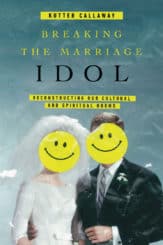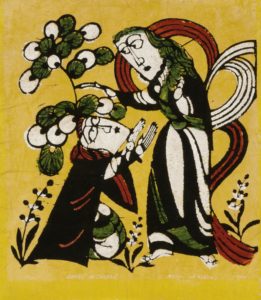
The necessity of marriage is seldom, if ever, questioned in our culture, whether secular or Christian. The centrality of marriage to our anthropology feels ubiquitous. More than once, I’ve heard pastors describe marriage from the pulpit as the “ultimate” human relationship, and rarely in church have I ever seen singleness treated as anything other than a “season of life” before you get married.
But Kutter Callaway dares to challenge such thinking in Breaking the Marriage Idol: Reconstructing Our Cultural and Spiritual Norms, shining a much-needed light on the church’s complicity in worshiping romantic love. His book stands out for the cultural commentary in the first section alone, where he provides a devastating analysis of the church’s idolatry of marriage. I would even go so far as to say these chapters ought to be required reading for anyone engaged in the ongoing conversation of Christian sexuality.
However, the remaining two sections of Callaway’s book lack the insight of his earlier chapters. Many of his ideas come across as underdeveloped, and many of his more controversial claims lack an adequate defense. As a result, the book succeeds in exposing much of the problematic thinking behind evangelical assumptions about sex and marriage, but it ultimately fails to provide adequate answers to the questions it raises.
A Cultural Analysis of Marriage
Callaway opens his book with a scathing critique of the “bedfellow” relationship between evangelicalism and the secular obsession with romantic love. His cultural analysis is nothing short of phenomenal. With sharp insight, he traces the roots of Christian purity culture, courtship rhetoric, and popular notions of “biblical manhood and womanhood” to the same sorts of philosophical assumptions fueling consent culture, serial monogamy, and Prince Charming fairy tales.
“[Evangelical ministries] are constructing and disseminating a particular narrative about marriage, singleness, and sexuality that is strikingly similar to the one embodied by the music of popular artists like Taylor Swift,” Callaway says. “The key difference is that whereas Swift chooses to direct her sexual energies toward serial monogamy, evangelicals direct their erotic desires toward marriage.” In other words, the packaging might look different, but it’s the same exact ingredients producing the same exact form of idolatry.
“[Evangelical ministries] are constructing and disseminating a particular narrative about marriage, singleness, and sexuality that is strikingly similar to the one embodied by the music of popular artists like Taylor Swift.”
His treatment represents a breathtaking indictment against the evangelical approach to marriage and sexuality that deserves far more attention than it has received. While numerous Christians pride themselves in keeping their distance from the promiscuity of our culture’s sexual liberation, Callaway argues that “they have in fact adopted a nearly identical set of assumptions and commitments.”
In short, Callaway calls out one of the biggest sins of the evangelical church today, and he does so more effectively than any other writer I’ve seen on the topic. His book is worth reading if only to experience his unveiling of the illicit marriage between secular culture and evangelicalism.
Putting Marriage in Its Proper Place
Callaway also does an outstanding job of creating a new vision for what ought to be truly central to a Christian anthropology, arguing that community is central to our relational humanity, not marriage. “[T]he answer to being alone is not marriage,” he argues. “It’s community. Better yet, it’s communion, primarily with God and also with each other. This is how the biblical narrative understands what it means to be fully human.”
Within church community, Callaway argues that Christians have a God-given responsibility to cultivate intimacy that “both precedes and surpasses the kind that derives from genital expression.” And he further calls upon the church to create “new stories” about single individuals that “culminate not in their marriage but in their being and becoming persons in relation.” In so doing, he wisely identifies the imagination of believers as the first battlefield in changing the way Christians think about human sexuality.
Refreshingly, Callaway also reminds believers that chastity is a virtue both single and married people alike must pursue, contrary to the misguided assertions of documents like the “Nashville Statement.” Whether married or celibate, he argues, we all must learn to direct our sexual energies in ways that do not culminate in sex:
“Whether one is single or married, a fully flourishing human life simply does not come about by acquiring the object of one’s sexual desires. Instead, it only ever comes about when we are altogether freed from our obsessive quest for personal wholeness through sexual expression. The lifelong process of directing and disciplining our sexual desires is not about finding an ‘appropriate’ Christian expression for one’s sexuality. It’s about cultivating a generative space in which we routinely set aside our own desires so that [the other person] might thrive.”
Later, he observes that “living with sexual integrity is far more complex than just saying no. It’s about all of us—single and married alike—being and becoming a chaste community.” By calling both single and married people alike to chastity, Callaway corrects the gross misunderstanding of this virtue that currently proliferates in evangelical circles.
Marriage As a Social Mechanism?
Unfortunately, as Callaway gets further into the book, he raises far more questions than he is equipped to answer, significantly weakening the overall impact of his message.
Most notably, Callaway asserts that marriage ought to be understood primarily as a social mechanism through which God works justice. He references Jacob’s polygamous marriage to Rachel and Leah as one example among many, observing that “we are given no indication that the marriages themselves were in any way illicit. If anything, God responds not by punishing them for their marital indiscretions, but by blessing them all the more.”
Callaway later clarifies that he is not attempting to justify polygamous marriage, but it nevertheless remains unclear just what exactly he is attempting to justify. A few pages later he writes:
“I simply want us to acknowledge a difficult truth: When it comes to determining either (a) who is or is not meant to be married or (b) what a ‘godly/Christian/biblical’ marriage does or does not entail, members of the Christian community are often guilty of arbitrarily elevating those portions of Scripture that confirm our preconceptions while conveniently ignoring those that do not. …Interestingly, the biblical authors are not incredibly worried about setting moral boundaries for marriage (although ethics certainly does play a role here). They are more concerned with urging God’s people to enact justice in every sphere of life…”
In short, Callaway argues that marriage is primarily a cultural institution whose boundaries are defined by what best promotes God’s justice in society. Why, for example, could Jacob marry Rachel even though he was already married to Leah? According to Callaway, justice. Why was a man required to marry the widow of his brother, even if he was already married? Once again, justice. Examples abound in Scripture of God blessing marriages that don’t conform to the traditional “ideal.” “When we look at the actual biblical data,” he argues, “it becomes increasingly evident that the biblical authors saw marriage not as an ideal type, but as a cultural given.”
Unanswered Questions
The problem is that Callaway’s argument sounds an awful lot like the sort of thing you might hear from someone defending any sort of marriage outside the cultural norm. “Both marriage and ‘marital relations,’” he argues, “seem to be less about God’s original design and more about a response to a broken and disordered creation.” But if God is more concerned about utilizing marriage as a social mechanism to protect the marginalized, then shouldn’t that also extend to gays and lesbians?
As Callaway puts it, God blessed all sorts of marital arrangements in ancient Israel that would be considered illicit today, but he did so in the interest of protecting women, for whom marriage functioned as a shield against oppression. But if that’s the case, wouldn’t God still bless all sorts of marital arrangements today in the interest of protecting the marginalized? For millions of LGBTQ+ people, marriage functions as a shield against the soul-crushing loneliness of an individualistic culture. If God bent the heterosexual-monogamy rules in ancient Israel to protect the vulnerable, why wouldn’t he still do so today?
Callaway doesn’t seem to recognize the implications of his thinking and, as a result, never actually addresses the questions his arguments raise. Given his choice to have Joshua Beckett, a celibate gay Christian, write the chapter on singleness, I can only assume he supports a “traditional” sexual ethic…thus making his progressive-sounding argument all the more confusing.
Biting Off More Than You Can Chew
Callaway’s choice to define marriage through the lens of justice, without doing the necessary groundwork to defend such an idea, significantly undermines the impact of this book. Challenging marriage idolatry is enough to ruffle feathers, let alone asserting that marriage doesn’t have an “ideal form.” Them be fightin’ words. So it’s a bit perplexing that Callaway doesn’t foresee these issues and take pre-emptive steps to address them.
Instead of making assertions about marriage that he isn’t fully prepared to defend, it might have been better for Callaway to expend greater energy developing a more practical framework for existing as a fully sexual being apart from sex and marriage. Granted, he dedicates an entire chapter to celibacy and singleness; but this chapter remains highly esoteric, providing a multitude of abstractions with very little concrete guidance.
A number of Callaway’s insights do promise a more concrete approach. He observes, for example, that single people are only ever seen as recipients of ministry, never givers. It would have been wonderful to see him expound further upon this idea, and discuss practical ways to change things. He also suggests that we need to “attempt to create a space in which [sexual] impulses might produce something constructive” apart from sex and marriage. But aside from a brief discussion of music and creativity, he offers precious little by way of suggestions for how to actually do this.
Conclusion
I would use caution in issuing a carte blanche recommendation for Breaking the Marriage Idol. Some people might be turned off by Callaway’s more controversial assertions, and thus disregard his valid insights elsewhere. But I would recommend it to anyone with an interest in Christian sexuality who is able to appreciate an insightful but less-than-perfect book.
Ultimately, Breaking the Marriage Idol is worth your time if you’re willing to forgive some of its underdeveloped ideas. Callaway’s analysis of romantic idolatry in both secular and evangelical culture is beyond outstanding, and his call to create “new fairytales” that don’t culminate in marriage is a call that we desperately need. His book is an important, if incomplete, contribution to the ongoing discussion of Christian sexuality, singleness, and marriage.
Bridget Eileen works full time for a mental health organization providing education and support for marginalized women. She writes about LGBT+ issues and Christian sexuality on her blog and elsewhere.
works full time for a mental health organization providing education and support for marginalized women. She writes about LGBT+ issues and Christian sexuality on her blog and elsewhere.


